| Oracle® Argus Insight BOXI Administrator's Guide, Release 6.0 E18285-01 |
|
 Previous |
 Next |
In addition to the pre-formatted Standard Reports, Argus Insight also provides Cubes, that let you create custom reports for ad hoc/special reporting requirements.
|
Note: Make sure that when using Cubes, you have ENABLED the Interactive mode in BO Infoview. You can enable the Interactive mode by editing My Preferences for Web Intelligence. |
A Cube is a data model that contains multiple dimensions (key reporting elements). You can observe and analyze the interactions between reporting elements by performing operations such as nesting, drill, sort, count, and total. Argus Insight provides six built in Cubes pertaining to varied reporting aspects.
|
Note: Before using cubes, make sure to install FixPack 1.2 on top of the BOXI R3.1 release. |
The following topic explains how to use the custom report tools by using cubes.
A Cube is a data model that consists of dimensions and measures. The dimensions represent key reporting aspects in rows and columns headers of the data model. At the intersection of each row and column (a cell), the Cube shows a measure, such as case, report, or event count. In this version of Argus Insight, you access Cubes through the Business Objects® XI Web Explorer interface. The interface uses a web browser and provides access to available dimensions and measures.
Using Cubes, you can run complex queries by selecting various datamart fields as dimensions and display the output on the fly. You can also select the desired measures. To display the exact data you require, you can add filters, add calculations, drill down hierarchical dimensions, and statistically analyze the measures. Cubes also let you explore the interactions between different dimensions by letting you nest dimensions.
Argus Insight lets you create Demand Cubes (Cubes on the Fly) based on existing Standard Cubes in Argus Insight. The difference between the two types of cubes is-
Standard Cubes: These cubes are built-on the entire database.
Demand Cubes: These cubes are built on specific case series.
The structure of a Demand Cube is similar to the structure of the Standard Cube. This is because a Standard Cube acts as a base for creating Demand Cubes.
The following topics explain how to work with Cubes.
Working with Cubes
Cubes Available in Argus Insight
Creating Demand Cubes
Performing Drill-Through Operations
Saving Cubes Views
Refreshing Cubes
This topic explains how to execute and use Cubes.
Use the following procedure to execute a Cube
In Argus Insight, select Datamart Reports >Cubes>All.The Cubes page displays all the built-in Cubes in Argus Insight. To view Cubes in a specific category, first select Datamart Reports > Cubes and then select a category name: Compliance, Management, or Pharmacovigilance.
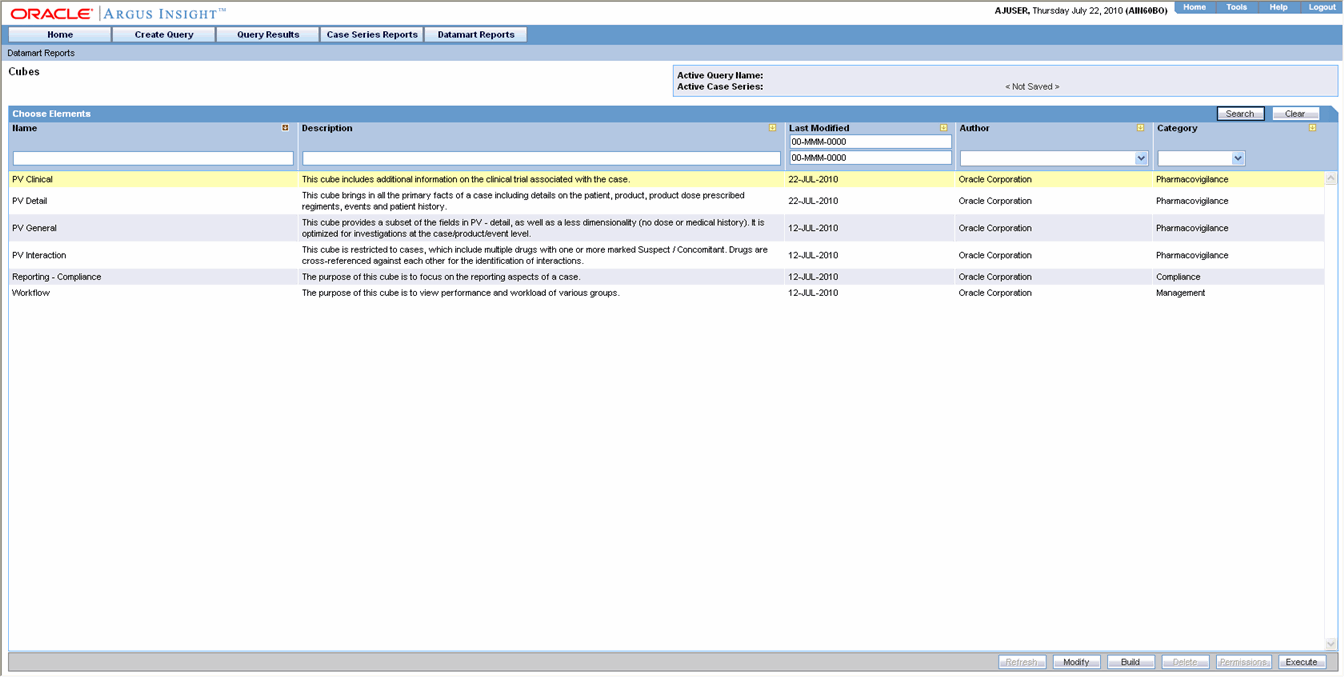
Select the Cube you wish to execute.
Click Execute. A separate BOXI Web Explorer window displays the Cube in the interface similar to the one shown in the following figure.

The left frame of the BOXI Web Explorer window displays the available dimension categories (reporting aspects) in a tree hierarchy. The Variables folder in the tree structure contains the available measures for the Cube. The report output area in the right frame displays the Cube structure, which is similar to a crosstab report. The dimensions from the first two categories appear as rows and columns in the Cube, respectively. To explore dimensions from other available categories, you can replace the existing dimensions in the Cube or nest other dimensions with the existing dimensions. You can also filter the output or drill down the dimensions in the Cube to display specific data.
Click Edit on the toolbar.
The following sections explain the basic BOXI Web Explorer options that let you work with Cubes.
You can select a dimension to filter a Cube in order to reduce the data displayed in the Cube output. Unlike the drill operation, filtering does not change the existing Cube layout. Instead, it changes the measure values displayed in the Cube output according to the dimension you select as the filter. An example follows.
In the PVClinical Cube, the default row dimensions are from the Protocol ID: Protocol Number category and the default column dimensions are from the Initial Received Date:Year category. At the intersection of each row and column dimension the Cube displays the total Case Count. However, instead of viewing the total Case Count for the existing dimensions, you may wish to view the Case Counts for a specific country of incidence. Use the following procedure to view Case Counts for a specific country of incidence.
While the PV Clinical Cube is open, select Available Objects from the drop down box in the upper-left corner of the BOXI Web Explorer page.The left pane displays all the dimension categories available for the PV Clinical cube
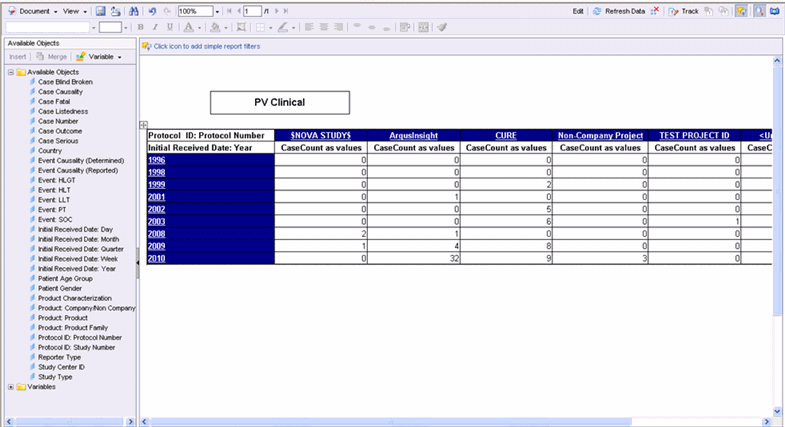
In the right pane, right-click underneath the table to access the Add Filter icon from Filter text menu. The Report Filter Editor displays the various options you can use for filtering data.
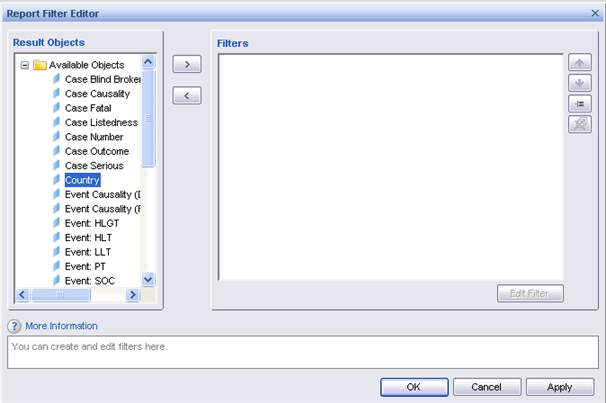
Select Country from the Result Objects pane and click >. The Filter dialog appears.
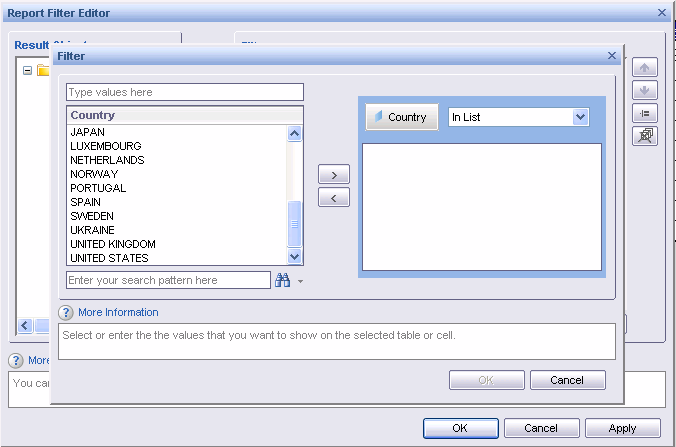
To define the country to be used as filter criteria, select the appropriate operator and value. In this example we have selected the In List operator to select from a list of countries.
Select the country to be used as a filtering criteria. In this example, we have selected United States as the filtering criteria.
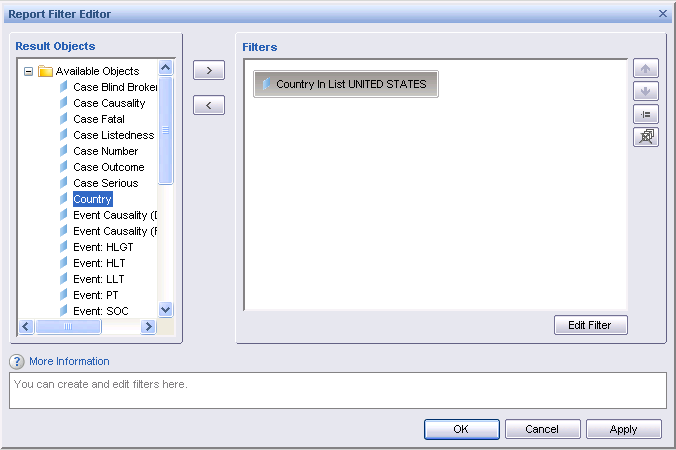
While the layout of the PV Clinical Cube remains the same, the data in the Cube output changes to display the measure values specific to the selected country.
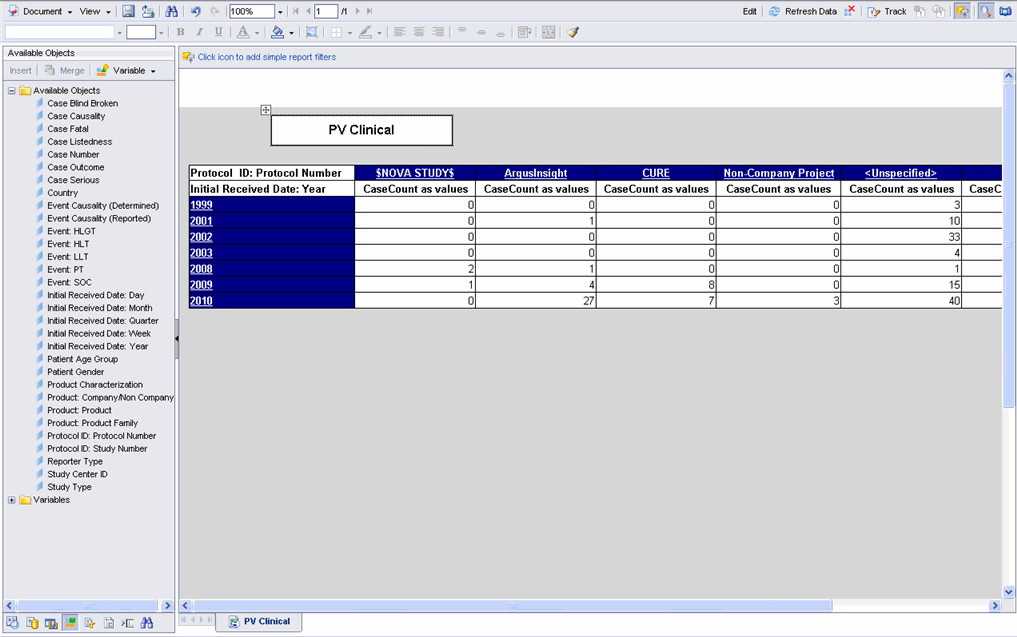
You can filter the output further by selecting another dimension as the filtering criterion.
|
Tip: To filter a Cube based on the existing dimensions displayed in the Cube output, click a dimension within a dimension row or column. The Cube output is filtered to display the data for the selected dimension. |
Use the following procedure to remove the filter.
Select the Document Structures and Filters from the drop-down box in the upper-left corner of the BOXI Web Explorer page
Select the filter to be removed.
Click Remove.
For example, to remove the Country in List UNITED STATES filter described in the example above, select in the categories filter, and click Remove.
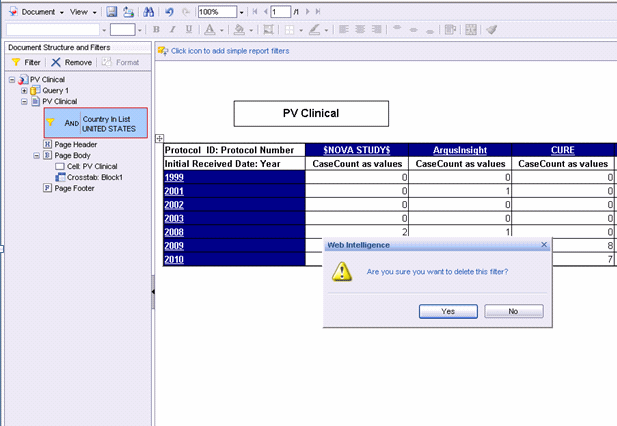
You may want to replace the existing row or column dimensions with dimensions from another category to observe the interaction between dimensions from different categories. To do this, you can drag a category or a dimension from the left dimensions pane of the BOXI Web Explorer window into the middle of any cell of the column or row you want to replace. An example follows.
In the PVClinical Cube, the default row dimensions are from the Protocol ID: Protocol Number category and the default column dimensions are from the Initial Received Date:Year category.

Similarly you can replace the existing column dimensions with other dimensions. You can also replace the existing row/column dimensions with a single category from a dimension by dragging the category from the left pane into the middle of a row/column cell.
Use the following procedure to replace existing row dimensions with Study Type dimensions.
Select the Study Type dimension from the left dimensions pane .and drag the dimension from the left frame to the middle of any row cell in the Cube.
|
Note: Drag and drop the dimension(s) into the middle of the cell row/column.Do not drop the dimension(s) onto the row/column header. |
The existing row dimensions in the Cube are replaced with the Study Type dimension.
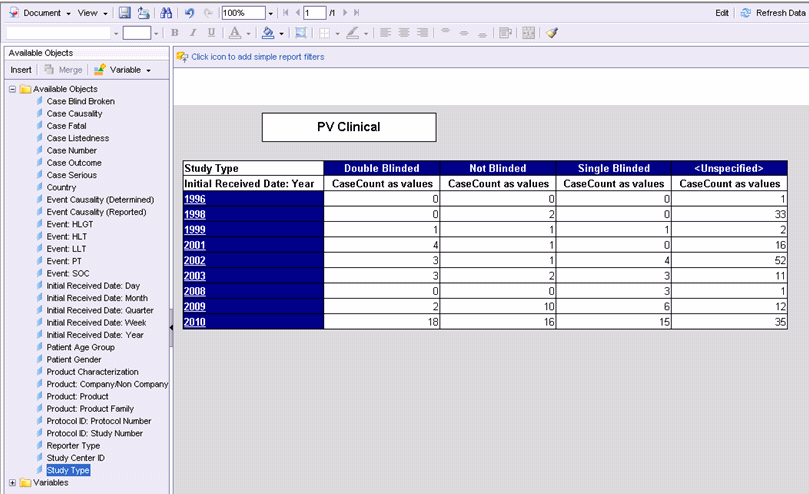
You can have multiple rows and columns in a Cube by dragging additional dimensions from the tree structure (left pane) into the Cube. When you add a new entity to a Cube, the output is automatically grouped to let you view data easily. Row grouping happens by the leftmost row entity and column grouping happens by the topmost column entity.
Groupings can be obtained as follows:
To obtain a row grouping by a new entity, select an entity from the tree structure in the left frame of the BOXI Web Explorer window and drag it into the left or right edge of the row area within the Cube. The Cube output refreshes to show the grouping depending on the edge of the row area where you dragged the new entity.
To obtain a column grouping by a new entity, select an entity from the tree structure in the left frame of the BOXI Web Explorer window and drag it into the upper or lower edge of the column area within the Cube. The Cube output refreshes to show the grouping depending on the edge of the column area where you dragged the new entity.
You can remove specific groupings from the Cube by deleting a dimension row or column from the Cube. The procedures follow.
To remove a dimension row from the Cube, right click on the table as shown in the illustration.
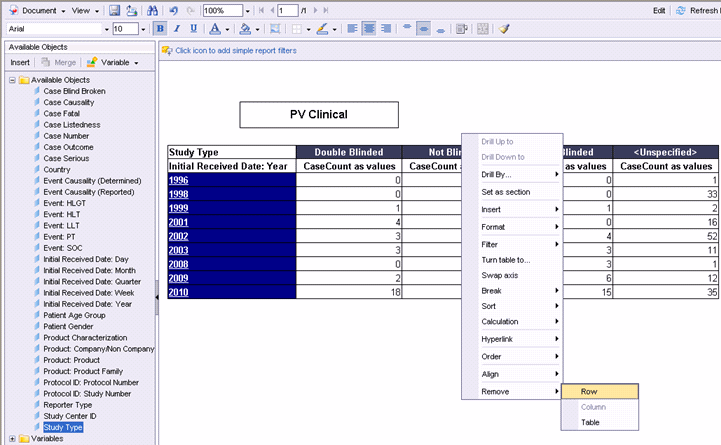
In the context menu that appears, click Remove > Row to delete the dimension row.
Use the following procedure to remove a dimension column from a Cube.
To remove a dimension column from the Cube, right click on the table as shown in the illustration.
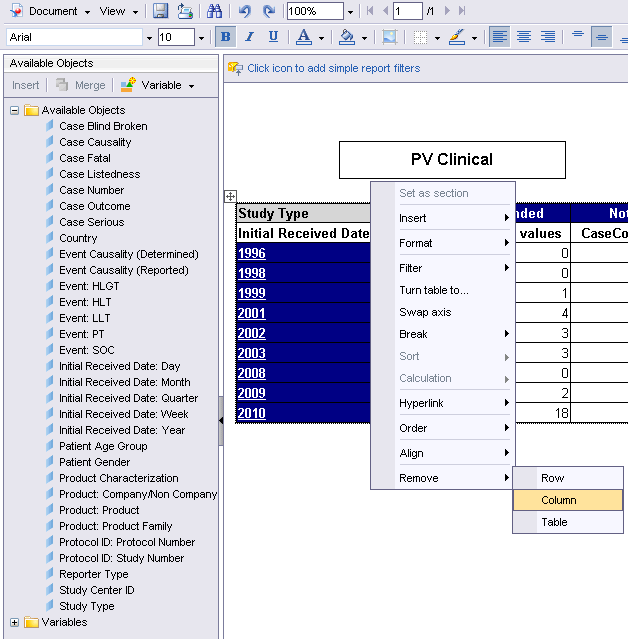
In the context menu that appears, click Remove > Column to delete the dimension column.
You can display a Cube as a chart to graphically see patterns and trends in data.
Perform the necessary operations on the Cube to get the desired reporting focus.
Right click on the table, in the right panel of the BOXI web explorer. A context menu displays the Turn table to option.
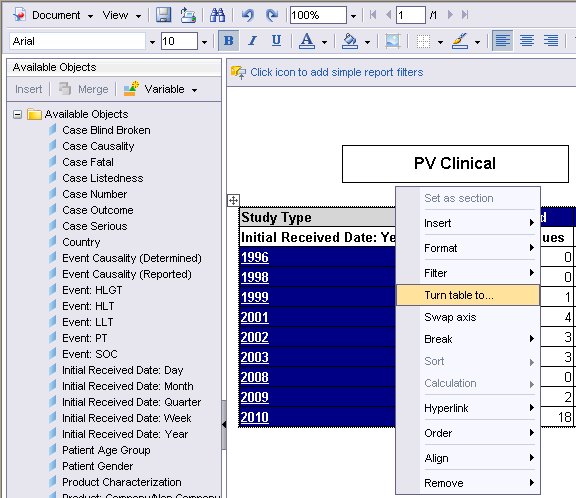
Click the Turn Table to option. Select the required format from the Turn Table to dialog box.

The cube data is displayed in the selected format.
You may want to swap the rows with columns in a Cube that has few rows and many columns. This improves the readability of the Cube output.
To interchange rows and columns in a Cube, right click on the table and select the Swap axis in the context menu that appears as shown in the illustration.
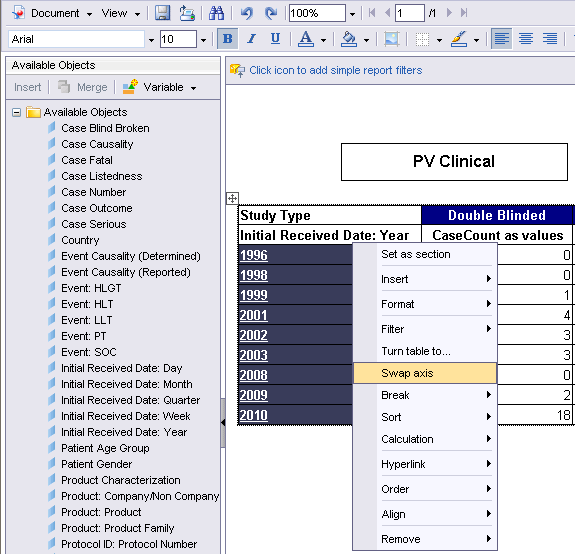
|
Tip: If there are multiple/grouped rows or columns in the Cube, the outermost rows become the outermost columns, and the outermost columns become the outermost rows. |
You can export the Cube output to formats, such as PDF, EXCEL, and CSV, and save the file on the local machine.
Perform the necessary operations on the Cube to get the desired reporting focus.
If required, change the Cube layout to a crosstab or chart, as appropriate.
Click Document > Save to my computer on the BOXI Web Explorer toolbar. A context menu displays the available export options.
Select the desired export option (EXCEL, PDF or CSV)
Specify the file settings for the selected export option such as file location, to save the file onto your system.
The reporting focus of Cubes that have multiple dimensions available can be changed by replacing an existing measure within the Cube with another measure. For example, Pharmacovigilance Cubes have Case Count (row,column, grand or values) as available measures. While the default measure displayed in these Cubes is Case Count, you can replace it with the percentage total of (row,column, grand or values) to change the reporting focus.
Use the following procedure to change the measures.
While the PV Clinical Cube is open, select Available Objects from the drop down box in the upper-left corner of the BOXI Web Explorer page. The left pane displays the Variables folder which consists of all the measure categories available for the PV Clinical cube.
Select Variables. The measures available for the Cube are displayed.
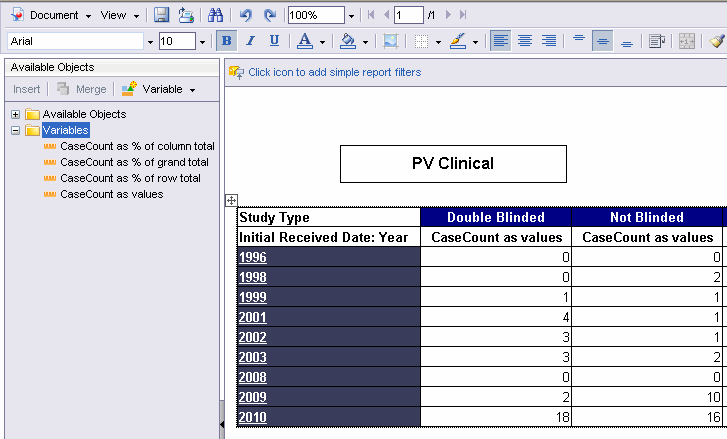
Click and drag the measure required, onto the data cell. The crosstab output is refreshed; Case Count as % of grand total is the new measure added to the Cube.
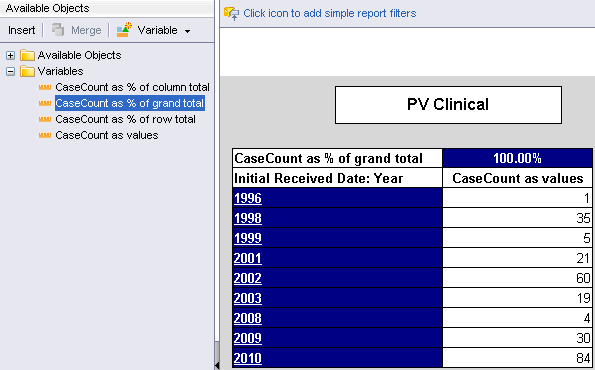
|
Tip: Drag the measure and place the cursor after the data in the cell, to display the original data of the cell and it's percentage as per the measureIf you simply drag the measure onto the cell data, the tabular data is displayed as per the measure percentage |
The available measures for all the six cubes are:
CaseCount as % of column total
CaseCount as % of grand total
CaseCount as % of row total
CaseCount as % of values
Use the following procedure to modify the Cube.
In Argus Insight, select Datamart Reports>Cubes>All. The Cubes page displays all the built-in Cubes in Argus Insight and the Demand Cubes which the group users have created.

Select the required Cube and click Modify.
The Modify cube interface appears. This interface helps you to capture information to modify the Cube.
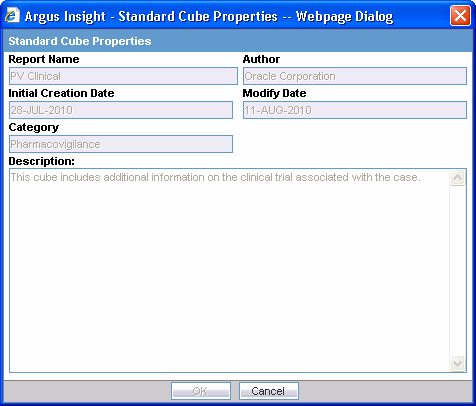
Expiration Date informs you about the expiration date of the cube. You are notified when the expiry date is due and you can save or delete the existing cube as per preference. This field is visible only for Demand cubes.
Initial Creation Date captures the date when the Cube was loaded in the repository for the first time.
Modify Date captures the date when the Cube was last modified.
ETL Run captures the date of ETL run on which the case data is based. This field is visible only for demand cubes. This field is visible only for Demand cubes.
Case Series captures the name of the case series on which the cube was built. This field is visible only for Demand cubes.
To delete the Cube:
Use the following procedure to delete the Cube:
In Argus Insight, select Datamart Reports >Cubes > All. The Cubes page displays all the built-in Cubes in Argus Insight and the Demand Cubes which the group users have created.

|
Note: You cannot modify or delete Standard Cubes. |
Select the required Cube and click Delete.
The Delete cube confirmation dialog appears. Click OK to confirm the operation.
You can set group-level access permissions for the Demand Cubes. This determines which user groups can view, modify, or delete a Demand Cube.
|
Note: You can set permissions only on Demand Cubes you have saved to the system. |
Use the following procedure to set Demand Cube permissions.
In the Argus Insight page, select the Datamart Reports > Cubes > All.
Click Permissions. The Permissions dialog box appears. A list in this dialog box displays the names of all the groups (except the Administrator group) that the system administrator has created.
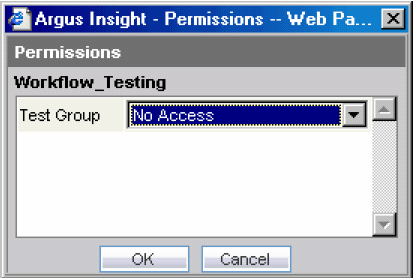
Use the list box next to a group name to assign permissions to the group members on the Demand Cube you have selected. You can select from these options:
| Permission | Description |
| No Access (Default) | No group members can access the Case Series |
| Full Access | You can modify/delete/view the Cube |
Click OK. The system saves the permission settings.
Argus Insight provides six different Standard Cubes grouped in categories to let you analyze your safety data from Compliance, Management and Pharmacovigilance perspectives.
| Category | Cube Name |
|---|---|
| Compliance | Reporting Compliance |
| Management | Workflow |
| Pharmacovigilance | PV Clinical, PV Detail, PV General, PV Interaction |
The dimensions available in a Cube depend on the type of analysis that the Cube lets you perform. The following types of measures are available.
| Measures | Available in |
| Case Count | All Cubes in Pharmacovigilance, Management and Compliance categories. |
The following sections describe the various Standard Cubes available in Argus Insight. For information on executing and working with Cubes, see the Working with Cubes topic.
The Compliance category consists of the Reporting Compliance Cube
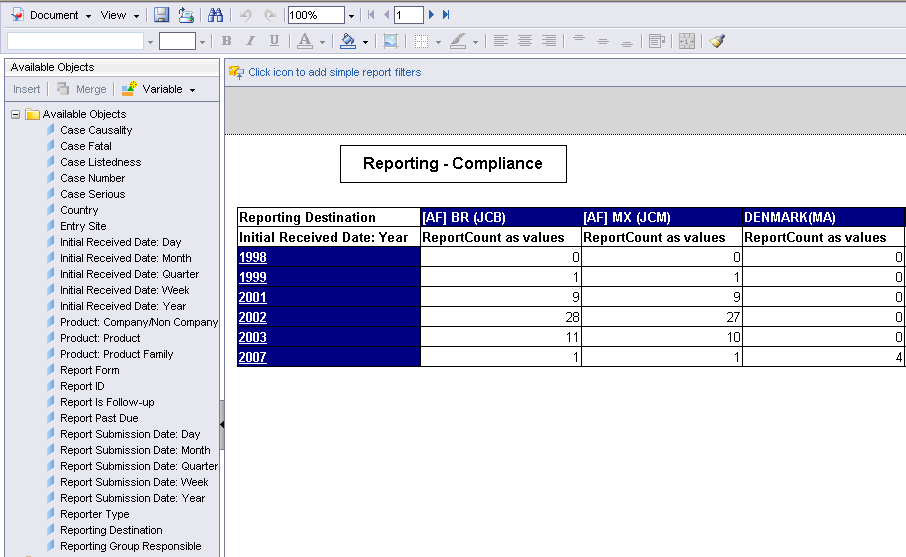
The Reporting Compliance cube lets you explore the following dimensions:
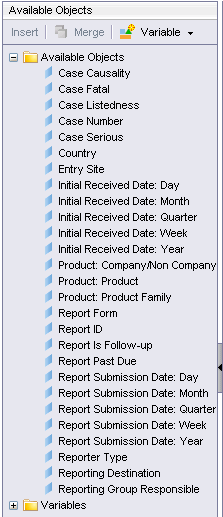
The Management category consists of the Workflow cube:
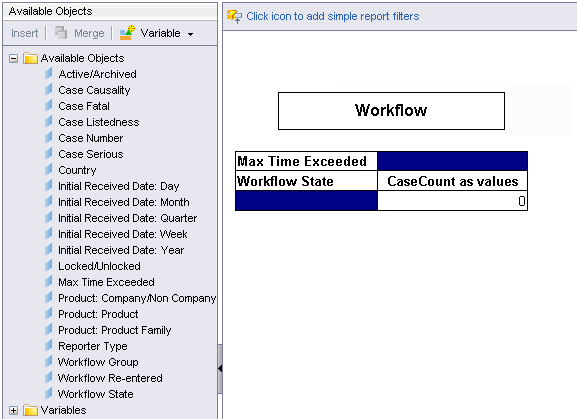
The Workflow cube lets you explore the following dimensions:
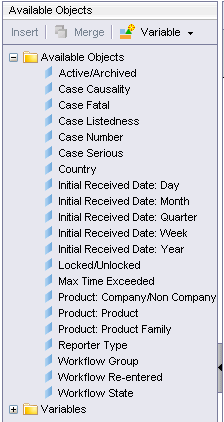
Argus Insight lets you create demand Cubes based on existing standard Cubes in Argus Insight. The structure of a demand Cube is similar to the structure of the standard Cube you select to build the demand Cube. For more information on performing operations on Cubes refer to the section on Working with Cubes.
Demand Cubes are based on a specific Case Series instead of the entire datamart. Therefore, you can use demand Cubes to analyze a reduced data set based on a specific Case Series and quickly obtain the desired reporting focus without having to drill down or filter data. However, this feature makes the demand Cubes static, which means that each time the Case Series is modified, you need to delete the demand Cube and create a new one.
Use the following procedure to create a demand Cube.
In Argus Insight, select Datamart Reports >Cubes>All. The Cubes page displays all the built-in Cubes in Argus Insight.

Select the standard Cube using which you wish to create the demand Cube. The Cube name is highlighted; the Build button becomes active.
Click Build. The Cube Properties dialog box appears.

Enter the demand Cube name in the Cube Name text box.
Enter the demand Cube description in the Description text area.
Use the Case Series list box to select the Case Series on which you want to create the demand Cube. The description of the selected Case Series appears in the associated Description text area.
Click Build Cube. The Cubes - Build dialog box notifies you that the Cube has been scheduled for generation on the BOXI server.
Click OK. The Cubes page displays the demand Cube name in grey.
When the WebI server generates the demand Cube, the Cubes Generated dialog box notifies you. After the Cube is generated, you can execute it by selecting the Cube name and clicking Execute.
|
Note: The maximum number of cases for creating Demand Cubes are configurable from the List Maintenance items. |
Demand Cubes have a limited life span on the system. The system deletes the demand Cube after 14 days (default) from the date of creation.
When the demand Cube has reached the expiration date, the system notifies you through the following dialog box.
At this point, you can either delete the demand Cube or retain it for another 14 days (default).
This section describes the procedure to drill through cubes for standard and demand cubes.
Use the following procedure to execute a Cube.
In Argus Insight, select Datamart Reports >Cubes>All.The Cubes page displays all the built-in Cubes in Argus Insight and the Demand Cubes which the group users have created.

Select the Cube you wish to execute.
Click Execute. A separate BOXI Web Explorer window displays the Cube in the interface similar to the one shown in the following figure.

You can drill-down and drill-up hierarchical dimensions to explore different aspects of your work and to move between levels of information. You can drill-down and drill-up multiple levels at a time. When you drill-down on a dimension that groups other dimensions in a row or column, some information may be removed from the Cube.
An example to demonstrate the drill functionality for listing Case Numbers associated with the initial received date (in years) follows.
Use the following procedure to drill down to the next level in a hierarchical dimension, such as a Case Series.
Drag and drop the Case Number dimension from the left pane into the right pane, underneath the table.
|
Tip: If you cannot see the dimension list in the left pane, select Available Objects from the drop down list in the left pane. |
The Cube output changes to display the data for all the Case Number dimensions.

While the preceding steps let you display the data for all the lower levels for all the products, you may change the reporting focus by only displaying the lower-level data for a specific product. To do this, simply click on the dimension in the Cube output.
This section describes the procedure to save Cube views (based on the drilled-down data). You can access these saved cube views from Datamart Reports > Cubes > Library
Use the following procedure to save Cube views.
Click Datamart Reports > Cubes All to view all the cubes.
Select the Cube view that you want to save. The name of the cube is highlighted
Click Execute. BOXI web explorer is displayed
Perform the desired drill through operation. The cube view is displayed.
Click Document > Save As in the menu bar. The options for saving the report appear.
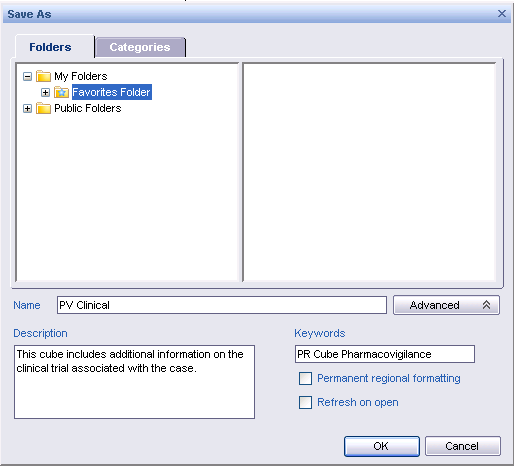
|
Tip: You can access Document > Save to my computer as to save the cube on your system in Excel, PDF or CSV (with options) format. |
Enter and save the Title, Description and Keywords.
Select the location at which the cube view should be saved. Public Folder > Argus Insight > Standard Cube Category > Analysis
|
Note: You cannot save Cube views in the Demand Cubes folder. You must save the Cube view in the Analysis folder within any Standard Cube category. |
Click OK to save the cube view.
To view the saved Cube view, click Datamart Reports > Cubes > Library. The Cube view name appears in the list of cubes saved in the library.
|
Note: Standard Cubes: If the data mart has been updated since the last saved view, the information displayed within the cube will reflect the updated data as the view of the Cube is saved.Demand Cubes: If the data mart has been updated since the last saved view, the information displayed within the cube will remain static as it is based on static case series. |
The Cube views can also be shared as viewswith other users.
Although the ETL process updates the datamart on a regular basis, you need to separately update each Cube after the incremental ETL process is completed. To do this, a batch process needs to be set up to update the Cubes installed as part of the Argus Insight application. The batch process performs the following task:
Updates Cube data - the data in the Cube is updated with the latest data from the datamart
Individual tasks need to be scheduled to update each Cube. To improve the performance of the batch process, Verify that individual batch execution processes do not overlap with each other.
|
Note: Demand Cubes are refreshed sequentially. |
This section explains the procedure for scheduling batch generation by using Windows Task Manager. You need to perform this procedure for each of the six Cubes. The steps follow:
Select Start > Settings > Control Panel > Scheduled Tasks. Double-click the Add a Scheduled Task item.

Click Next in the Schedule Task Wizard window.

Click Browse to navigate to another folder location.

Navigate to the following location: <Argus Insight Installation Folder>\PowerReports\CubeGenThis is the path of the folder where the Argus Insight application is installed on the system drive. For example D:\Relsys\PowerReports\CubeGen.
Select the Cube_Generation_Driver.bat file.
Click Open to select the Cube_Generation_Driver.bat file

In the text box for entering the task name, type Cube Generate 1.The task name should be entered in the format Cube Generate <Cube ID>. The Cube IDs are listed in the table below.
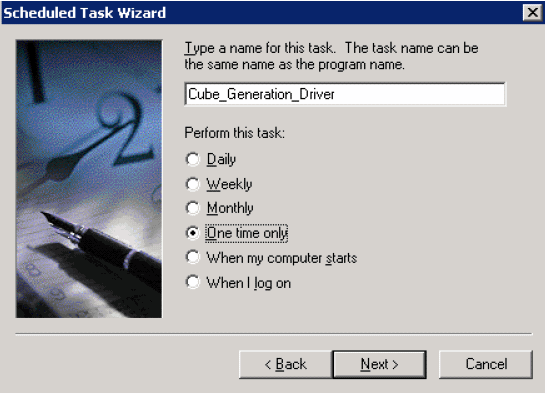
| Cube Name | Cube ID |
|---|---|
| PV Clinical | 1 |
| PV General | 2 |
| PV Interaction | 3 |
| PV Detail | 4 |
| Reporting Compliance | 5 |
| Workflow | 6 |
Use the Perform this task option button group to set the frequency of the task, as appropriate.
Click Next to proceed to the next step.
Set the Start Time and Start Date.
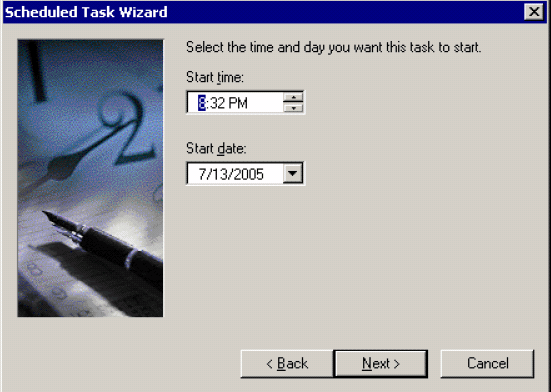
Click Next to proceed to the next step.
Enter the user name and password of the user authorized to run this task
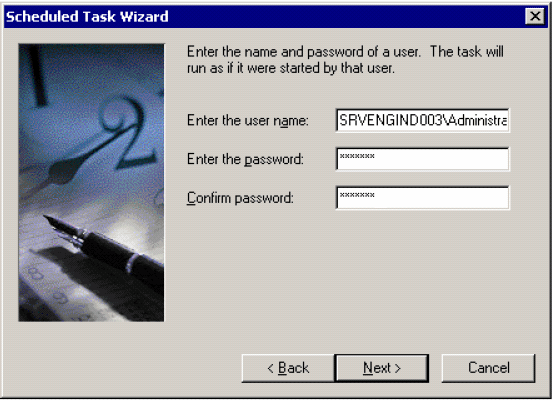
Click Next to proceed to the next step.
Check the Open advanced properties for this task when I click finish checkbox
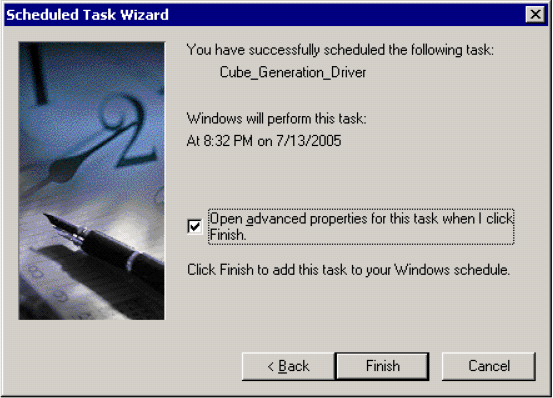
Click Finish. The dialog box for setting advanced properties for the task appears
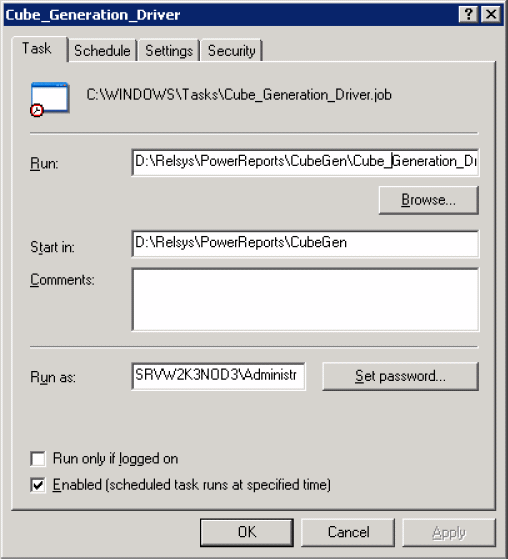
In the Run text box within the Task tab, enter the run-time parameter for this task in the following format:<Argus Insight Installation Folder>\PowerReports\CubeGen\Cube_Generation_Driver.bat" <Cube ID>where CubeID is the ID of the Cube for which you are scheduling the batch generation.Include the double quotation marks (" ") while entering the runtime parameter. The table below lists the Cube ID for each cube and provides examples of the run-time parameter to be entered.
| Cube Name | Cube ID | Example Run-Time Parameter |
|---|---|---|
| PV Clinical | 1 | "D:\Relsys\ArgusInsight\CubeGen\Cube_Generation_Driver.bat" 1 |
| PV General | 2 | "D:\Relsys\ArgusInsight\CubeGen\Cube_Generation_Driver.bat" 2 |
| PV Interaction | 3 | "D:\Relsys\ArgusInsight\CubeGen\Cube_Generation_Driver.bat" 3 |
| PV Detail | 4 | "D:\Relsys\ArgusInsight\CubeGen\Cube_Generation_Driver.bat" 4 |
| Reporting Compliance | 5 | "D:\Relsys\ArgusInsight\CubeGen\Cube_Generation_Driver.bat" 5 |
| Workflow | 6 | "D:\Relsys\ArgusInsight\CubeGen\Cube_Generation_Driver.bat" 6 |
Click Set Password to set the password.
Enter the password for the BOXI Server admin user. Click OK.
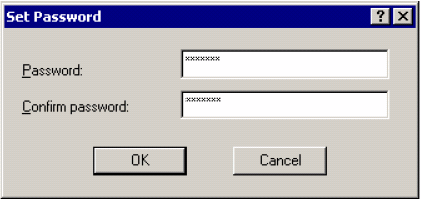
Select the Schedule tab to set the schedule options, as appropriate.

Select the Settings tab.
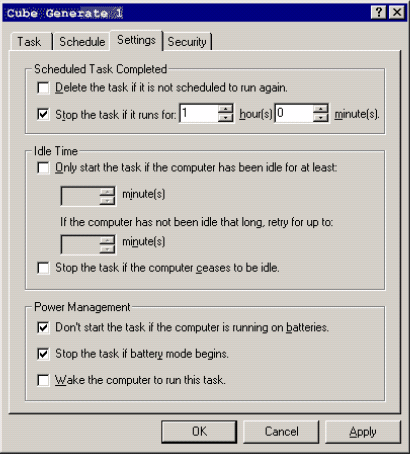
In the Scheduled Task Completed and Power Management sections, set the options as shown in the illustration above.
Select the Security tab to verify that the user has full permissions assigned.
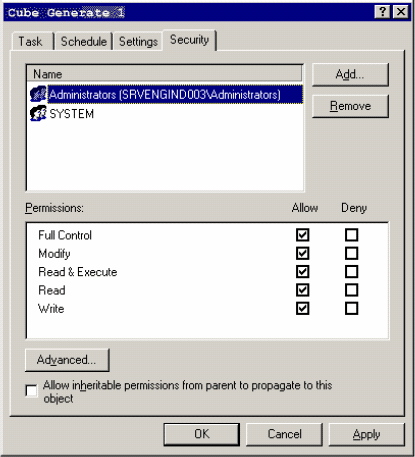
Click OK.The system creates the new scheduled task Cube Generation 1.Repeat the above steps to schedule batch generation for the remaining cubes.
These settings are optional. Theses settings are not the recommended settings for running the Argus Insight and should only be configured if CIOMS and MedWatch are not running on the environment.
Go to Start > Run and type dcomcnfg and press Enter.
In the tree under Console root > Component Services > Computer > My Computer > DCOM Config.
Right click on the PwReports in the list and click Properties.
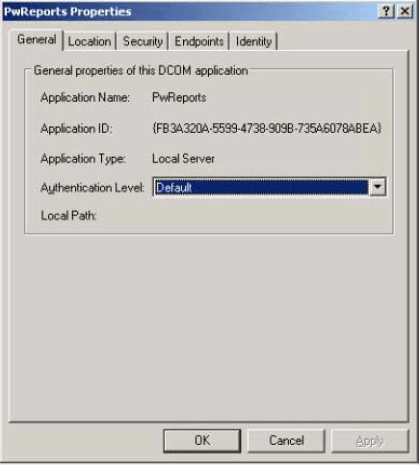
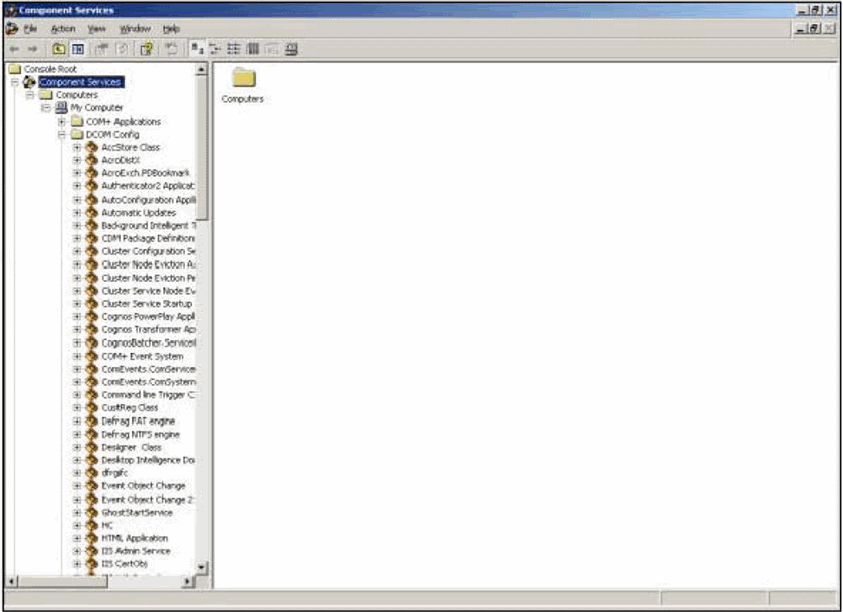

Click the Security tab.

In the Launch and Activation Permissions Mark Customize and click Edit.
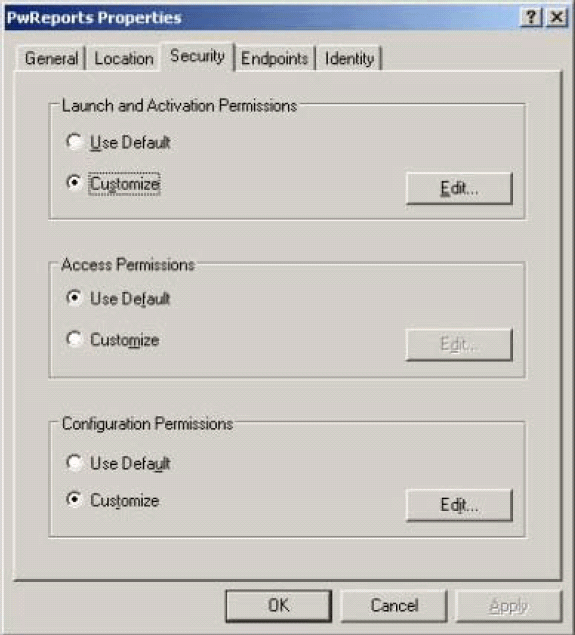
ClickAdd.
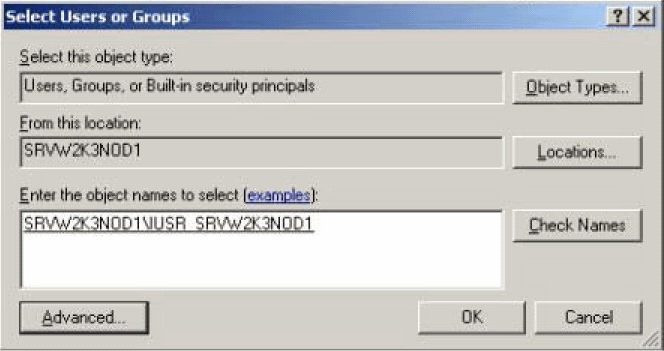
Under the Enter the object names to select (examples) add <machine_name>/IUSR_<machine_name> and click OK
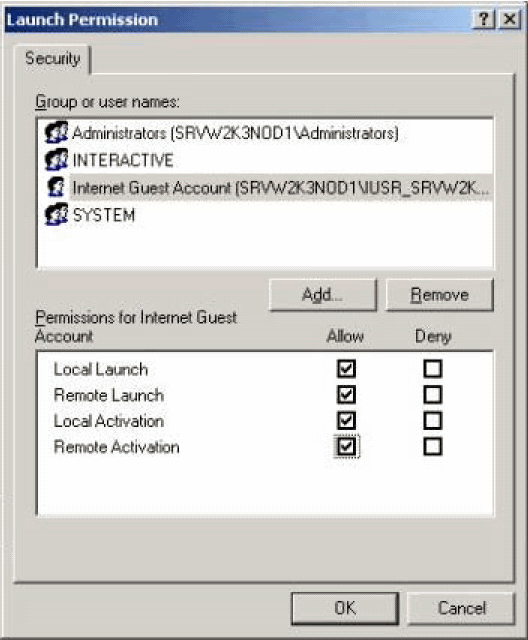
Select the newly created Internet Guest Account and check all the permissions.
Click Ok.
Exit the Component Services program.